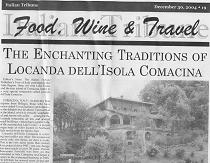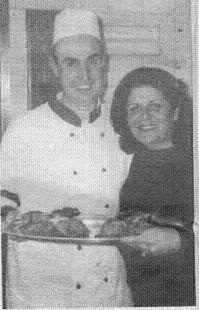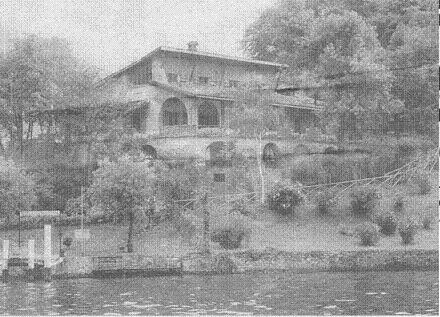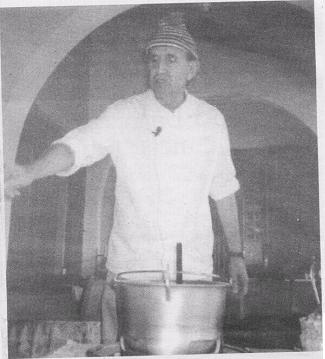
The Enchanting Traditions
of
Locanda dell'Isola Comacina
Editor's Note: The Italian Tribune
Publisher's Tour of Italy continues to the
Lake Region. Here, we visit Lake Como
and the tiny island of Comacina, home to
a very special restaurant called Locanda
dell'lsola Comacina.
COMACINA, ITALY - As their tiny boat
departs from Bellagio, those who have
never visited Comacina have yet to discov-
er the delights that lie ahead. Upon arrival
at the island, which is virtually uninhabit-
ed and serves only as the setting for the
Locanda restaurant, an inn, and several
small buildings, visitors have a grand view
of the surrounding Lake Como - a pictur-
esque body of water located in Northern
Italy not far from the Italian Alps.
Locanda dell'lsola Comacina is a din-
ing spot unlike any other. The restaurant
serves only one menu, six days a week.
This is the very same menu that visitors
have enjoyed since 1947 - not one change
has been made in over 50 years. Owner
Benvenuto Puricelli was born on the
mainland in Sala Comacina and began a
career in the restaurant business in 1963.
He left Italy for several years, living and
working at the Palace Hotel in St. Moritz,
Switzerland; participating in the 2500th
anniversary of the Persian Kingdom at
Persopolis; and cooking as executive chef
at the Penthouse Club in London. He
returned to Italy in 1976, where he settled
in Comacina and succeeded Lino
"Cotoletta" Nessi as proprietor of the
Locanda restaurant.
' The menu at Locanda is simple and
nearly perfect, featuring typical, authentic
regional dishes that vary only slightly with
the seasons (the restaurant is closed every
year from November 1 through March. 1).
Every dish is all-you-can-eat, and a white
D.O.C. wine is served with the meal.
The first course is Antipasto all'Isolana.
Each guest is served a slice of tomato,
topped by a slice of lemon and seasoned
with salt, oil, and oregano. Then, eight
different fresh vegetables are paraded
out of the kitchen - celery, carrots, baked
onions, sweet peppers, courgettes, beans,
broccoli, and French beans. Slices of
Prosciutto di Praga and Bresaola della
Valtellina (salted beef dried in special cellars) are heaped on a separate plate.
For the second course, Trota alla
Contrabbandiera, the chef serves fresh
trout grilled on a hot plate over charcoal.
The trout is boned and dressed at the
client's table or in the kitchen.
Next is Rottami di Pollo in Padella,
free-range chicken opened and
"crushed," and then fried in an iron pot
with oil. The chicken is served with salad.
The fourth course is called Grana
aIl'Escavadora - a simple chunk of
famous Parmigiano-Reggiano cheese. At
the table, a piece of the cheese is cut from
the middle of the wheel and given into
the hand of each dinner guest.
For dessert, guests are served Arance
alla Castellana. Oranges are sliced at the
table and served in an exquisite ice cream
called fior di vaniglia. The entire dish is
covered with creme all'isolana. The type of
fruit served varies seasonally, usually
peaches are substituted.
The meal's extraordinary finale is a
Locanda tradition that is never broken. At
the sound of a bell, Benvenuto himself
enters the dining room adorned in a special
wool cap. As he prepares the meal's finishing touch in a large, copper pot at the table
- coffee with brandy - he explains the leg-
end of the island of Comacina.
According to local historians, the
village of Comacina flourished and
prospered even back during the period
when the Lake Region was merely fjords
of the Adriatic Sea. The Romans con-
quered the village and its inhabitants
moved south, where they founded the
two villages of Como and Vico - which
eventually joined to form the present city
of Como.
Greeks arrived after the
Romans, and when the Roman
Empire converted to Christianity
the early pagan temples built on
the island were consecrated as
churches. The five original
churches on the island became a
refuge for Christians and served
as a fortress for the people when
the Barbarians, hoping to conquer
the region, wreaked havoc on the
surrounding area. At this time,
the Christian refugees began to
build homes on the island and
Comacina took the name
Cristopolis, or "City of Christ."
One of the refugees was the
great Frandlione, who fled to the
island during the invasion of the
Lombards. He brought with him a
horde of treasure that he had been
able to save from the vandalism of
the Barbarians, but the treasure
was soon coveted by Aufharis, the
husband of Theodolina, who
directed his troops to besiege and
conquer the island.
After six months of battle,
Francilione surrendered to
Autharis. Autharis granted peace
and allowed Francilione to take
refuge in Ravenna. The inhabitants
of the island were spared massacre
and were able to continue living on
the land.
Throughout the years, numer-
ous dethroned kings and princes
settled in Comacina, which had
come to be known as an oasis of
peace. Even saints settled on the
island, as the quiet village was a
perfect place to lead a life of med-
itation and prayer. Saint Abonde
brought the Saint Euphemia cult
to the island. Other religious
iconic inhabitants include Saint
Agrippa, Bishop of Como, and
Saint Domenica.
Little by little, Comacina's
power continued to increase.
During the famous Ten Years
War, the island became Milan's
ally in a struggle against Como.
The island was, however, journeying to ruin and in 1127 an
unknown poet known as "The
Anonymous Cumano" cursed
the island with the phrase,
"Island, cursed by thou
throughout the ages!"
Forty-two years later, Comacina was captured by Como,
Queen of the Lake. Every fortification was destroyed, including
the five churches and the island's
castle. The inhabitants that survived the attack fled.
Years passed and grass invaded the ruins of the island, which
passed from one ruler to another until it became property of
the Bishop of Como in 1196.
Later., Cardinal Durini attempt-
ed to recover Comacina from
abandonment and turn it into a
sort of earthly paradise. His
noble quest failed.
Much later in 1911, Auguste
Caprini of Sala Comacina purchased the last lot of land on the
island, thus becoming the sole
owner of Comacina. Upon his
death, he bequeathed the land to
King Albert I of Belgium. The
little island was sacrificed with
painful emotion during the sad
years of World War I, but after
the war Comacina was rightful-
ly returned to Italy. In 1927 a
royal decree placed the island
under the rule of Princess
Marie-Jose, daughter of Victor-Emmanuel III.
By this appointment, Comacina came to be governed by two
commissions. The first, headed
by the Minister of National
Education and the Belgian
ambassador, had its seat in
Rome. The other, with its seat in
Milan, was governed by the Fine
Arts president and the Belgian
consul, which proposed building
homes on the island for Belgian
and Italian artists. After the intervention of Eugene Brenna, the
mayor of the island, three houses
by the architect Pierino Lingeri
were constructed.
Unfortunately, World War II
prevented the completion of the
project and the houses remained
abandoned. It was only recently
that the structures could reassume their initial role, with help
from the architect Paolo
Candiani, President of the Fine
Arts Academy.
An inn was completed during
the mid-20th century, and since
1964 has offered peace to visitors.
The flags of Italy and Belgium
still fly outside the building.
Today, Locanda restaurant
owner Benvenuto continues to
practice mysterious fire rituals to
ward of the mysterious curse of
The Anonymous Cumano.
Most recently, George Clooney, Brad Pitt, Julia Roberts and
the rest of the cast of Ocean's
Twelve visited Lake Como and
Comacina after the completion
of the film. Their photos, along
with photos of numerous other
celebrities who have visited
throughout the years, adorn the
walls of the Locanda restaurant.
For more information, contact
Locanda dell'Isola Comacina by
phone at 0344.55083 or by visit-
ing the web site at www.locanda-isola-comacina.com. The
restaurant is located at 22010
Sala Comacina, Lago di Como.
 |
CHEF ANTONIO OSTINELLI
of Locanda dell'Isola Comacina
presents the third course of his
specially prepared dinner,
Rottami di Pollo in Padella. He
is pictured here with Marion
Fortunate, wife of Italian Tri-
bune Publisher Buddy For-
tunato, who recently enjoyed a
meal at the restaurant during
the Italian Tribune Tour of
Italy. Locanda, located on the
island of Comacina, Italy, has
been serving the same menu,
six days a week, since 1947. |

LOCANDA DELL'ISOLA COMACINA, one of northern Italy's best eateries, is nestled on a gorgeous island in the middle of
Lago di Como, Italy. The tiny island of Comacina is shrouded in local legend, having been cursed in 1127 by a mysterious poet,
and since surviving numerous sieges and conquests throughout the years. Today, visitors to the island are enchanted by its
beauty and by its haunting past.
 |
BENVENUTO PURICELLI, second-generation owner of the
Locanda deU'lsola Comacina restaurant, is pictured during the end-
of-dinner ritual. Adorned in a distinctive woolen cap, Puricelli
recounts the legend of the mysterious island as he whips up an after
dinner coffee for his guests after a symbolic ringing of the bell.
|
 | MARION FORTUNATO hopes to pick up some culinary secrets
from the chefs at Locanda dell'Isola Comacina as they prepare a
fantastic dessert tableside. The dish, Arance alia Castella, consists
of fresh oranges,/for di vaniglia ice cream, and creme all'isolana
liquor. Who knows, the dessert may just show up on a future
Fortunatos' holiday table!
BACK |
Locanda dell'Isola Comacina - Ossuccio - Lago di Como - tel. ++39
0344 55083-56755 fax ++39 0344 57022 - e-mail email: [email protected] |